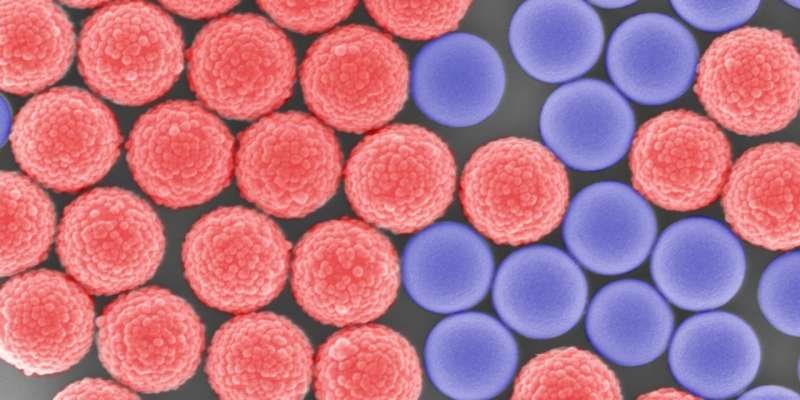It all comes down to roughness

Lucio Isa and his team of researchers have explained how the surface characteristics of microspheres affect rapid increases in the viscosity of suspensions, thus laying the groundwork for applications such as smoothly flowing cement.
The internet is full of videos of people having fun running over white slime. It almost looks as if they were walking on water. But when they stand still, they slowly begin to sink. The slime in question is usually a concentrated suspension comprising cornstarch and water. Although colloquially known as "oobleck" after the children's book by Dr. Seuss, materials scientists use the term "non-Newtonian fluid". In contrast to a "normal" (Newtonian) fluid, non-Newtonian fluids can become more viscous when acted upon by a large, rapidly changing force. For a brief moment, the material behaves like a solid. However, if the force is constant and weak, the material flows like a normal liquid.
"This phenomenon appears in all suspensions with high particle density, such as cement," says Lucio Isa, Professor of Interfaces, Soft matter and Assembly at ETH Zurich. If cement is pumped through a pipe on a construction site too quickly, the pipe will clog.
Higher friction due to rough surfaces
This is partially due to the surface characteristics of the solid particles in the suspension. "If a force is applied suddenly,the solid particles are unable to move out of the way quickly enough. Instead, they come into contact, rubbing against and blocking each other", Explains Isa. The rougher the particle surface, the higher the friction.
Researchers use these properties to control the sudden increase in viscosity in a dense suspension in a targeted manner. Instead of cornstarch, Isa and his colleagues "played" with uniform, micrometre-sized silicate particles with a rough surface. The particles look like tiny raspberries and had already been used by the researchers in earlier studies. Chiao-Peng Hsu, a doctoral student working under Isa and ETH professor Nicholas Spencer, has developed a method that allows him to quickly generate a library of these raspberry-shaped particles with different surface roughnesses.
Higher viscosity despite fewer particles
The researchers used these particles to create suspensions that they could test for sudden increases in viscosity under stress. The results showed that the rougher the particles, the fewer had to be added to the suspension to achieve sudden solidification. In contrast, if smooth particles were used, a greater amount had to be added to the suspension before the researchers were able to observe the sudden thickening.
The researchers showed that the use of rough particles could save material: their portion of the total volume in a suspension can be substantially lower in order to generate the same effect.
When the researchers mixed rough and smooth particles in a single suspension, solidification also occurred earlier than in suspensions with exclusively smooth particles. The ETH researchers discovered that as little as 6 percent of smooth particles in a mixture was enough to reduce the increase in viscosity significantly. "It's like mixing up ball bearings and gearwheels," says Isa. "The gearwheels link together relatively easily to create a stable chain but the ball bearings easily break those chains and enable flow."
In order to research the friction between individual particles, Hsu and his colleague Shivaprakash Ramakrishna attached a single, half-micrometre particle on a cantilever of an atomic force microscope. The researchers then moved the particle across various rough model surfaces by shifting the cantilever a few hundred nanometres while measuring the angle of tilt. The stronger the friction, the greater the angle. "Working with this kind of particle on a cantilever was extremely difficult, since the dimensions are incredibly small," emphasises Hsu. "We were the first group to accomplish this."
Applications in bullet-proof vests
Whether the results will be integrated into real-life applications remains to be seen. The study is primarily pure research. "Our goal was to investigate the ways in which we can change nano and microstructures in order to influence material behaviour on a macroscopic level, and we succeeded," says Isa. The findings could be used in everyday applications such as cement. "By adjusting the surfaces of granules and mixing them into cement in a similar way to our experiment, one could optimise cement's flow characteristics."
But viscous suspensions with abrupt solidification properties are also used for other purposes; for example, an American manufacturer uses viscous suspensions to develop bullet and stab-proof safety vests. "Our study can help improve these kinds of applications," says Isa.
More information: Roughness-Dependent Tribology Effects on Discontinuous Shear Thickening. PNAS, April 30th, 2018. DOI: 10.1073/pnas.1801066115
Journal information: Proceedings of the National Academy of Sciences
Provided by ETH Zurich





















